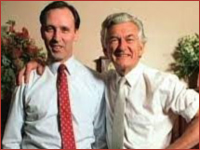 Former Prime Minister Bob Hawke once said, “We’re all Australians, whether we’re from Melbourne or Sydney”. Those from the ‘outlying States’ (as Paul Keating called them), naturally felt a bit left out.
Former Prime Minister Bob Hawke once said, “We’re all Australians, whether we’re from Melbourne or Sydney”. Those from the ‘outlying States’ (as Paul Keating called them), naturally felt a bit left out.
The confusing power structures between the States and the Federal Government – and between individual States – has been exposed during Covid with many calling for the abolition of State Governments and the formation of one national government.
As Covid has revealed, the Federal Government doesn’t have the power it thought it had. The States have the power. The Feds have the money.
When Australia came together as a nation in 1901 – as a federation of six individual British colonies – it did so after much debate. During the first of the convention debates in 1891, Sir Samuel Griffith, who would later become the first Chief Justice of the High Court of Australia, nailed it by saying:
“We must not lose sight of the essential condition that this is to be a federation of states and not a single government of Australia. The separate states are to continue as autonomous bodies, surrendering only so much of their power as is necessary for the establishment of a general government to do for them collectively what they cannot do individually for themselves.”
The powers given to the Federal Government by the States in 1901 included trade and commerce, corporations, currency, banking, pensions, taxation, foreign affairs, quarantine, and defence.
Not surprisingly, the first area where the boundaries between State and Federal Governments were tested related to tax. The fight over money began.
In 1942, all income taxing power was handed to the Federal Government for the duration of World War II under the ‘defence’ power of the Constitution. This was intended to be temporary and was to last until the end of the war. But as predictable as the sunrise, when the war ended the Feds did not relinquish their income tax collector role.
Since then, the tax revenue balance has continued to move away from the States and towards the Feds. The imbalance that now exists is known as ‘vertical fiscal imbalance’.
Australia has the highest level of vertical fiscal imbalance of any federal country in the world. The Federal government raises over 70% of all government revenues – much more than is required to fund its own operations – while the States don’t raise anywhere near enough to fund theirs. The Feds then make up the States’ shortfall through Commonwealth grants.
This creates a perpetual blame game. Failures at the State level are blamed on the Feds’ lack of funding, and failures at the Federal level are blamed on the States’ poor service delivery.
We cannot go on like this. The States and the Feds should only collect taxes for their own purposes, and taxpayers and consumers should be fully informed as to what is a State tax and what is a Federal tax. Those who spend the money should bear the responsibility of raising it.
Former Premier of Western Australia, Richard Court once said, “All the things that the States do best are under attack from the empire builders in Canberra. The bureaucracy running the Federal education system is large but it doesn’t teach any students. There is an equally large health bureaucracy which doesn’t treat any patients.”
Many of the most stable and productive nations on earth are federations of individual States. This is because as a principle not only of government, but also of life, the best decisions are made when the parties involved in the decision-making know and understand the issues intimately. Allowing States to make decisions on local matters is infinitely better than centralised decision-making thousands of kilometres away. It is by far the best way to govern a large and diverse country like Australia. Western Australia is very different to Tasmania. Who best then to make decisions affecting Broome or Burnie? Locals or Canberra-based bureaucrats?
Different States take different approaches to solving problems and achieving goals. This is far better than one big, central government making decisions for everyone.
Those who framed our Constitution certainly understood this.
Special note:
‘Family First’. You may have heard this week of the formation of a new political party called Family First. It is being set up by former Labor Party MPs Jack Snelling and Tom Kenyon. So you are aware, neither of them approached or informed anyone at the Australian Family Party before the news broke. As the former Chairman of what was once Family First, I always welcomed the opportunity to work constructively with like-minded Parties in the political arena – the DLP (I sat with the late John Madigan in the Senate from 2014 – 2016), Australian Christians, Rise Up Australia, Fred Nile’s Christian Democratic Party and others. The Australian Family Party trusts it can come to similar arrangements with this new party.